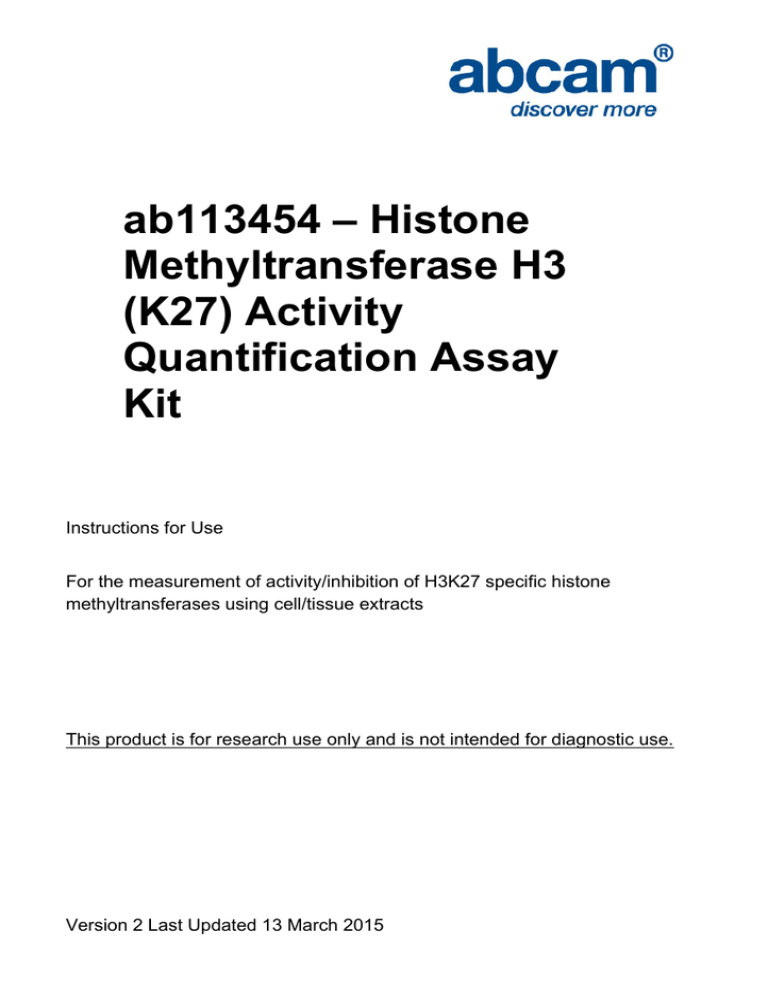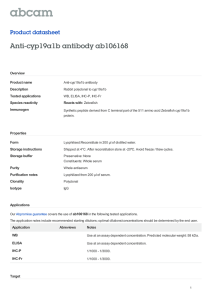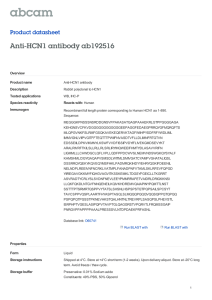ab113454 – Histone Methyltransferase H3 (K27) Activity Quantification Assay
advertisement

ab113454 – Histone Methyltransferase H3 (K27) Activity Quantification Assay Kit Instructions for Use For the measurement of activity/inhibition of H3K27 specific histone methyltransferases using cell/tissue extracts This product is for research use only and is not intended for diagnostic use. Version 2 Last Updated 13 March 2015 Table of Contents INTRODUCTION 1. BACKGROUND 2. ASSAY SUMMARY 2 3 GENERAL INFORMATION 3. 4. 5. 6. 7. 8. PRECAUTIONS STORAGE AND STABILITY MATERIALS SUPPLIED MATERIALS REQUIRED, NOT SUPPLIED LIMITATIONS TECHNICAL HINTS 4 4 5 5 6 6 ASSAY PREPARATION 9. 10. REAGENT PREPARATION SAMPLE PREPARATION 7 8 ASSAY PROCEDURE 11. ASSAY PROCEDURE 9 DATA ANALYSIS 12. ANALYSIS 10 RESOURCES 13. 14. TROUBLESHOOTING NOTES Discover more at www.abcam.com 11 13 1 INTRODUCTION 1. BACKGROUND Histone methylation has been linked to a number of cellular processed including DNA repair, replication, transcriptional activation and repression. This process is regulated by Histone methyltransferases (HMTs), which are responsible for transferring methyl groups to the arginine and lysine residues of histone proteins. Lysine residues, which can be labelled with one, two or three methyl groups, are mainly modified in Histone H3 and histone H4. ab113454 provides a quick and efficient method to quantify HMT activity. This kit has the following features: Procedure can be completed within 3 hours. Simple colorimetric assay Manual or high throughput: flexible assay format thanks to strip microplate Quantitative determination of activity/inhibition of H3K9 histone methyltransferases ab113454 is designed for measuring Histone methyltransferases (HMTs) that specifically target histone H3 at lysine 27. In an assay with this kit, the histone substrate is stably captured on the strip wells through biotinstreptavidin binding. HMT enzymes transfer a methyl group to histone H3 substrate from Adomet to methylate the substrate at lysine 4. The methylated histone H3K27 can be recognized with a high-affinity antibody. The ratio or amount of methylated H3K27, which is directly proportional to enzyme activity, can be quantified through HRP conjugated secondary antibody-color development system. The HMT activity is then calculated based on the amount of methylated H3K27 converted by the HMTs. Discover more at www.abcam.com 2 INTRODUCTION 2. ASSAY SUMMARY Nuclear Extract Incubate with substrate and assay buffer Add capture antibody after wash Add detection antibody after wash Add developing solution and measure absorbance Discover more at www.abcam.com 3 GENERAL INFORMATION 3. PRECAUTIONS Please read these instructions carefully prior to beginning the assay. All kit components have been formulated and quality control tested to function successfully as a kit. Modifications to the kit components or procedures may result in loss of performance. 4. STORAGE AND STABILITY Store kit as given in the table upon receipt and away from light. Observe the storage conditions for individual prepared components in sections 9 & 10. The components of the kit are stable for 6 months when stored properly. For maximum recovery of the products, centrifuge the original vial prior to opening the cap. Check if 10X Wash Buffer contains salt precipitates before using. If so, warm (at room temperature or 37°C) and shake the buffer until the salts are re-dissolved. Discover more at www.abcam.com 4 GENERAL INFORMATION 5. MATERIALS SUPPLIED Quantity (48 tests) Quantity (96 tests) 10X Wash Buffer 11 mL 22 mL Storage Condition (Before Preparation) 4°C Histone Assay Buffer 1.5 mL 3 mL 4°C Adomet* 25 µL 50 µL 4°C Biotinylated Substrate, 25 μg/mL* 100 µL 200 µL -20°C HMT Standard, 10 μg/mL* 10 µL 20 µL -20°C Capture Antibody, 100 μg/mL* 25 µL 50 µL 4°C Detection Antibody, 100 μg/mL* 10 µL 20 µL -20°C Developing Solution 6 mL 12 mL 4°C Stop Solution 3 mL 6 mL 4°C Control Enzyme, 150 μg/mL* 10 µL 20 µL -20°C 6 12 4°C Item 8-Well Assay Strip (with frame) *Spin the solution down to the bottom prior to use. 6. MATERIALS REQUIRED, NOT SUPPLIED These materials are not included in the kit, but will be required to successfully utilize this assay: • Orbital shaker • Pipettes and pipette tips • Fluorescence microplate reader • 1.5 mL microcentrifuge tubes Discover more at www.abcam.com 5 GENERAL INFORMATION 7. LIMITATIONS Assay kit intended for research use only. procedures Do not use kit or components if it has exceeded the expiration date on the kit labels Do not mix or substitute reagents or materials from other kit lots or vendors. Kits are QC tested as a set of components and performance cannot be guaranteed if utilized separately or substituted Any variation in operator, pipetting technique, washing technique, incubation time or temperature, and kit age can cause variation in binding Not for use in diagnostic 8. TECHNICAL HINTS Avoid foaming or bubbles when mixing or reconstituting components. Avoid cross contamination of samples or reagents by changing tips between sample, standard and reagent additions. Ensure plates are properly sealed or covered during incubation steps. Complete removal of all solutions and buffers during wash steps. This kit is sold based on number of tests. A ‘test’ simply refers to a single assay well. The number of wells that contain sample, control or standard will vary by product. Review the protocol completely to confirm this kit meets your requirements. Please contact our Technical Support staff with any questions. Discover more at www.abcam.com 6 ASSAY PREPARATION 9. REAGENT PREPARATION Prepare fresh reagents immediately prior to use. 9.1 1X Wash Buffer Dilute 10X Wash Buffer with distilled water (pH 7.2-7.5) at a 1:10 ratio (example: 1 mL of 10X Wash Buffer + 9 mL of distilled water). 9.2 Adomet Solution Dilute Adomet with Histone Assay Buffer (at a 1:5 ratio). 1.5 μL of Adomet Solution will be required per well. 9.3 Capture Antibody Dilute Capture Antibody (at a 1:100 – 1:200 ratio) with 1X Wash Buffer 9.4 Detection Antibody Dilute Detection Antibody (at a 1:1000 ratio) with 1X Wash Buffer 9.5 HMT Standard Curve Dilute the HMT Standard in Histone Assay Buffer over range 10 to 0.2 ng/µL. Note: Keep each of diluted solutions except 1X Wash Buffer on ice until use. Any remaining diluted solutions other than 1X Wash Buffer should be discarded if not used within the same day. 10. SAMPLE PREPARATION Prepare nuclear extracts by using your own successful method. For your convenience and the best results, Abcam offers a nuclear extraction kit (ab113474) optimized for use with this Kit. Nuclear extracts can be used immediately or stored at –80°C for future use. Discover more at www.abcam.com 7 ASSAY PROCEDURE 11. ASSAY PROCEDURE 11.1 Determine the number of strip wells required. Leave these strips in the plate frame (remaining unused strips can be placed back in the bag. Seal the bag tightly and store at 4°C). 11.2 Add 24 µL of Histone Assay Buffer, 1.5 µL of the diluted Adomet, and 2 µL of Biotinylated Substrate to each strip well. Then add 3 µL of nuclear extracts (4-20 µg) or HMT enzymes, mix and cover the strip wells with Parafilm M and incubate at 37°C for 6090 minutes. For HMT inhibition, add 3 µL of tested inhibitors at different concentrations and reduce Histone Assay Buffer volume to 21 µL. For the blank, add 3 µL of Histone Assay Buffer instead of nuclear extracts. For the standard curve, add 3 µL of Histone Assay Buffer instead of nuclear extracts, and add 2 µL of HMT Standard at different concentrations (see section 9.5) instead of Biotinylated Substrate. A positive control can be optionally set up by adding 2-3 µL of the Control Enzyme instead of nuclear extracts. 11.3 Aspirate and wash each well with 150 µL of 1X Wash Buffer three times. 11.4 Add 50 µL of diluted Capture Antibody to each strip well and incubate at room temperature for 60 minutes on an orbital shaker (50-100 rpm). 11.5 Aspirate and wash each well with 150 µL of diluted 1X Wash Buffer four times. 11.6 Add 50 µL of the diluted Detection Antibody to each strip well and incubate at room temperature for 30 minutes. 11.7 Aspirate and wash each well with 150 µL of diluted 1X Wash Buffer four times. Allow 3 minutes for last wash. 11.8 Add 100 µL of Developing Solution into the wells and incubate at room temperature for 2-10 minutes away from light. Monitor the color development in the sample and standard wells (blue). 11.9 Add 50 µL of Stop Solution to each well to stop enzyme reaction when the color in the standard wells containing the higher Discover more at www.abcam.com 8 ASSAY PROCEDURE concentrations of standard control turns medium blue. The color should change to yellow and absorbance can be read on a microplate reader at 450 nm within 2-15 minutes. Discover more at www.abcam.com 9 DATA ANALYSIS 12. ANALYSIS Calculate HMT activity or Inhibition Simple Calculation Formulae: Activity (OD/h/mg) = No inhibitor OD – blank OD Protein amount (μg)* × hour** x 1000 * Protein amount added into the reaction at step 11.2. ** Incubation time at step 11.2 Inhibition % = 1–( Inhibitor sample OD – blank OD ) x 100% No inhibitor control OD– blank OD For accurate calculation, plot OD value versus amount of HMT Standard and determine the slope as delta OD/ng. Calculate HMT activity using the following formula: Activity (ng/h/mg) = Sample OD – blank OD Protein Amount (μg) × hour × slope Discover more at www.abcam.com x 1000 10 RESOURCES 13. TROUBLESHOOTING Problem No Signal for Both the Positive Control and the Samples Cause Reagents are added incorrectly Incubation time and temperature are incorrect No Signal or Very Weak Signal for Only the Positive Control No Signal for Only the Sample The positive control enzyme is insufficiently added to the well The positive control enzyme has lost activity due to incorrect storage The protein sample is not properly extracted The protein amount is added into well insufficiently. The sample is not prepared from fresh cells or tissues Nuclear extracts are incorrectly stored or have been stored for a long duration Absence of HMT activity in the sample due to treatment. Discover more at www.abcam.com Solution Check if reagents are added in order and if any steps of the procedure may have been omitted by mistake Ensure the incubation time and temperature in the protocol are followed correctly Ensure a sufficient amount of control enzyme is added Follow the guidance in the protocol for storage of the positive control Ensure the nuclear protein extraction protocol is suitable for HMT protein extraction. Sodium chloride concentration of the extraction buffer should not be more than 100 mM Ensure extract contains a sufficient amount of protein. The nuclear extracts from frozen cells or tissues significantly lose enzyme activity. Fresh samples should be used Ensure the nuclear extracts are stored at –80°C for no more than 6 weeks N/A 11 RESOURCES High Background Present for the Blank The well is not washed sufficiently Contaminated by the positive control of HMT standard. Overdevelopment Discover more at www.abcam.com Check if wash at each step is performed according to the protocol Ensure the well is not contaminated from adding the control enzyme or HMT standard accidentally, or from using enzyme or HMT standard contaminated tips Decrease development time in protocol step 11.8 12 RESOURCES 14. NOTES Discover more at www.abcam.com 13 RESOURCES Discover more at www.abcam.com 14 UK, EU and ROW Email: technical@abcam.com | Tel: +44-(0)1223-696000 Austria Email: wissenschaftlicherdienst@abcam.com | Tel: 019-288-259 France Email: supportscientifique@abcam.com | Tel: 01-46-94-62-96 Germany Email: wissenschaftlicherdienst@abcam.com | Tel: 030-896-779-154 Spain Email: soportecientifico@abcam.com | Tel: 911-146-554 Switzerland Email: technical@abcam.com Tel (Deutsch): 0435-016-424 | Tel (Français): 0615-000-530 US and Latin America Email: us.technical@abcam.com | Tel: 888-77-ABCAM (22226) Canada Email: ca.technical@abcam.com | Tel: 877-749-8807 China and Asia Pacific Email: hk.technical@abcam.com | Tel: 108008523689 (中國聯通) Japan Email: technical@abcam.co.jp | Tel: +81-(0)3-6231-0940 www.abcam.com | www.abcam.cn | www.abcam.co.jp Copyright © 2014 Abcam, All Rights Reserved. The Abcam logo is a registered trademark. RESOURCES All information / detail is correct at time of going to print. 15



![Anti-CD300e antibody [UP-H2] ab188410 Product datasheet Overview Product name](http://s2.studylib.net/store/data/012548866_1-bb17646530f77f7839d58c48de5b1bb7-300x300.png)
